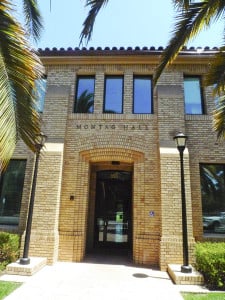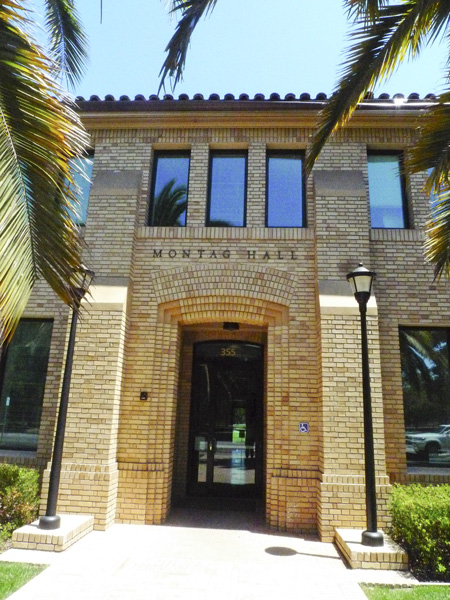
Coming off of the largest applicant pool in University history, the Office of Undergraduate Admissions plans on making significant expansions to its staff this year in order to keep pace with growing interest from prospective students.
Ten new part-time reader positions will be added this admissions cycle, bringing the number of individuals responsible for assessing applications up to 64. Training for these new readers starts at the end of October, in preparation for the first round of applications, due Nov. 1.
But that’s not the only change at Montag Hall, headquarters of Stanford admissions, this fall.
Bob Patterson stepped down from his post as Stanford’s director of admissions last June to become the director of college outreach at Chegg, Inc. The University named Colleen Lim as his replacement in August.
The office is also preparing for an expansion of its alumni interview program, which was approved by a Faculty Senate committee in April 2011. This year will be focused on building up the technological infrastructure to support what will eventually become a worldwide program, according to Dean of Admissions Richard Shaw.
Sonya Smith, who had previously worked in the office, was selected last month to oversee this expansion in a newly created associate dean position. She will transition to the new post on Oct. 1.
New Director of Admissions
Lim is not a newcomer to Stanford, having previously worked at the University from 2007 to 2009 as an assistant dean. She has known Dean Shaw for even longer than that — the two worked together when they were both employed at Yale University.
“That’s not my learning curve in this new position,” Lim joked, stating that their shared past work experience has helped to enhance communication.
To find Patterson’s replacement, the office conducted finalists’ interviews in June and July. According to Shaw, Lim was picked because of her past management experience, which he said is crucial given the large scope of the office’s operations.
“She has a proven track record as an exceptional manager,” Shaw said, referring to her past work as a senior associate commissioner in the West Coast Conference, in addition to her time at Stanford and Yale.
More application readers hired
Perhaps the biggest obstacle Lim will face in her new position is dealing logistically with a growing number of applicants. Last year, Stanford received almost 37,000 freshmen applications, a record for the University. This increase in candidates is expected to continue this admissions cycle.
“That is our challenge — that we do expect to have comparable numbers,” Lim said.
One step the office has taken to avoid this problem is expanding its part-time seasonal reader program. In addition to approximately 25 admission officers who read applications full time, the office employs individuals who are on contract to read for the University for five months of the year.
Last year, the office employed 28 part-time readers. That number will swell to 38 this year, according to the University’s 2012-13 budget report.
The office is currently in the process of hiring those seasonal readers, according to Lim. Shaw said applicants go through a competitive selection that involves an interview and case studies.
After being selected, readers will go through an on-campus training program with senior staff to prepare for the first rush of early applications on Nov. 1.
“We are working really hard right now to put our admissions staff in place to prepare for the reading cycle,” Lim said. “We anticipate [a high number of applicants], but we never know until it hits.”
The increasing number of applicants over the past several years has been a “natural progression,” according to Shaw. He said the numbers have risen as Stanford has appeared more frequently in the news for accomplishments in both the domains of academics and athletics.
Alumni interviews program expanding
As the office works to deal with an increasing application pool, it is also expanding its alumni interview program. After a three-year pilot period concluded in 2011, a Faculty Senate committee voted to make the program a permanent part of the University.
“Our long-term goal is to have a robust, worldwide interview program,” Lim said. “We realize it’s going to take steps to get there.”
Last year, students were granted an interview option if they had high school zip codes in Atlanta, Denver, New York City, Philadelphia, Raleigh-Durham or Washington, D.C.; attended school in the states of Maryland, Massachusetts, Minnesota, Oregon or Virginia; or studied internationally in Ireland or the United Kingdom.
This year, the program will expand to metropolitan Chicago and the entire state of Colorado, bringing the number of interviewing regions up to 14, according to Shaw.
Shaw said the key to sustaining the program would be establishing a strong software infrastructure before accelerating the expansion of the program.
The University gave the Office of Admissions a one-time injection of $200,000 in order to implement a new “constituent management system,” according to the 2012-13 University budget. The budget states that this new system will “integrate data from Stanford’s alumni database and provide an alumni online portal in support of the expansion of the alumni network interview program.”
The goal is to make an alumni interview an option for all applicants, including international applicants, in five years, according to the budget plan.
Smith will head up this charge as a new associate dean. As part of the Outreach Volunteer Alumni Link (OVAL), Smith is tasked with mobilizing Stanford alumni to share their experiences with prospective students.
She also holds alumni workshops to help train interviewers. Just last week, Smith held an alumni workshop in London, Lim said. Travel is likely to become even more common as the interview program expands.
Class of 2017
More subtle changes in the Office of Undergraduate Admissions have also taken place this year. For instance, staff members have met with University administrators and faculty to better understand the changes that will be implemented following last year’s Study of Undergraduate Education at Stanford (SUES).
While admission officers often do not have time to discuss specific policy changes with prospective freshmen, the report helps to reinforce the University’s “student-centered learning model,” according to Lim.
Despite all of these operational changes, Shaw said the admissions cycle should continue as normal this year.
“It’s what we do every year — this is our business,” Shaw said. “Every year, we are selecting a class and hopefully presenting them every September at Convocation. There’s a lot involved, and right now, all the staff involved in this operation are out on the road, looking for the Class of 2017.”
Alice Phillips contributed to this report.
